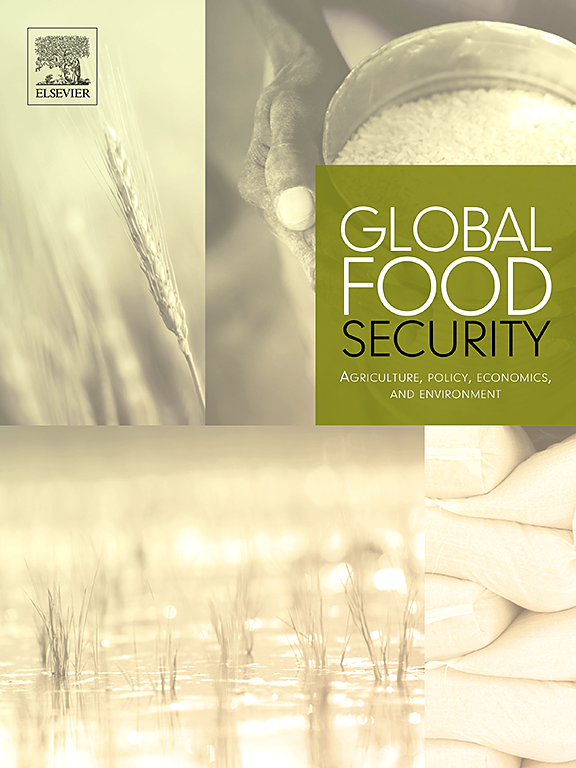Meta-analysis of the impacts of digital information interventions on agricultural development
IF 9.6
1区 经济学
Q1 FOOD SCIENCE & TECHNOLOGY
Global Food Security-Agriculture Policy Economics and Environment
Pub Date : 2025-06-01
DOI:10.1016/j.gfs.2025.100866
引用次数: 0
Abstract
Digital means of delivering advisory and other information services to small-scale agricultural producers are widely expected to expand the reach of extension and other information provision services while reducing costs. However, there is currently little evidence systematically quantifying these benefits. In this paper, we synthesize quantitative information on the impacts of digital information interventions, which may integrate human support, on adoption of modern farm inputs (fertilizer and improved seeds), yield, and income, covering interventions implemented between 2005 and 2019. Our starting point for the meta-analysis was the Agriculture in the Digital Age Evidence Gap Map dataset, which provided a consistent set of studies of digital interventions, though one limitation is that it excludes more recent studies published after 2021. After applying our criteria for relevance, rigor, and availability of necessary data, we used estimates from 20 studies in our analyses where fifteen were from Sub-Saharan Africa, four from India, and one from Cambodia. Mean impacts of digital information interventions on adoption of fertilizer (+23 %; 95 % CI +6 % to +40 %), yield (+6 %; +2 % to +9 %), and income (+6 %; +2 % to +9 %) are positive while effects on adoption of improved seeds were not statistically significant. Although our analysis indicates that digital farmer services have provided benefits on average, there is considerable variability in estimates across individual studies. However, there are not enough comparable quantitative observations from the literature included within our study population to reliably further disaggregate estimated impacts (e.g., by intervention, level of human assistance, geography, modality of information delivery, farmer type). Expansion of the available evidence base to facilitate quantification of these heterogeneous impacts is needed to better inform program design to maximize effectiveness.
数字信息干预对农业发展影响的meta分析
人们普遍预期,向小规模农业生产者提供咨询和其他信息服务的数字手段将扩大推广和其他信息提供服务的范围,同时降低成本。然而,目前很少有证据系统地量化这些好处。本文综合了2005年至2019年间实施的数字信息干预措施对现代农业投入品(肥料和改良种子)采用、产量和收入影响的定量信息,这些干预措施可能整合了人力支持。我们的荟萃分析的起点是数字时代的农业证据差距图数据集,该数据集提供了一组一致的数字干预研究,尽管一个限制是它排除了2021年以后发表的最新研究。在应用我们的相关性、严谨性和必要数据的可用性标准后,我们在分析中使用了来自20项研究的估计,其中15项来自撒哈拉以南非洲,4项来自印度,1项来自柬埔寨。数字信息干预对肥料采用的平均影响(+ 23%;95% CI + 6% ~ + 40%),产量(+ 6%;+ 2%至+ 9%),收入(+ 6%;+ 2% ~ + 9%)为正,而对改良种子采用率的影响无统计学意义。尽管我们的分析表明,数字农民服务平均而言提供了好处,但在各个研究的估计中存在相当大的差异。然而,在我们的研究人群中,没有足够的可比较的文献定量观察来可靠地进一步分解估计的影响(例如,通过干预,人类援助水平,地理位置,信息传递方式,农民类型)。需要扩大现有的证据基础,以促进这些异质影响的量化,从而更好地为项目设计提供信息,以最大限度地提高效率。
本文章由计算机程序翻译,如有差异,请以英文原文为准。
求助全文
约1分钟内获得全文
求助全文
来源期刊

Global Food Security-Agriculture Policy Economics and Environment
FOOD SCIENCE & TECHNOLOGY-
CiteScore
20.90
自引率
3.40%
发文量
69
期刊介绍:
Global Food Security plays a vital role in addressing food security challenges from local to global levels. To secure food systems, it emphasizes multifaceted actions considering technological, biophysical, institutional, economic, social, and political factors. The goal is to foster food systems that meet nutritional needs, preserve the environment, support livelihoods, tackle climate change, and diminish inequalities. This journal serves as a platform for researchers, policymakers, and practitioners to access and engage with recent, diverse research and perspectives on achieving sustainable food security globally. It aspires to be an internationally recognized resource presenting cutting-edge insights in an accessible manner to a broad audience.
 求助内容:
求助内容: 应助结果提醒方式:
应助结果提醒方式:


